|

Autumn 2005 (13.3)
Pages
28-31
Building Boom
- The New Baku:
A Disaster in the Making
by Thomas Goltz
Search AZER.com
1. "Construction! Destruction?
Blueprint for Baku's Urban Development" by Pirouz Khanlou.
AI 13.3 (Autumn 2005).
2. "UNESCO:
Baku's Old City Listed as World Heritage Site". AI 8.4
(Winter 2000).
3. "Architecture
of the Oil Baron Period". Introduction by Betty Blair.
Building descriptions by Fuad Akhundov, Shamil Fatullayev, Fakhreddin
Miralayev and Jala Garibova, AI 6.4 (Winter 1998).
4. Entire issue of Azerbaijan International: "Glimpse
of Glory: Inside Oil Baron Mansions". AI 13.2 (Summer
2005).
5. "Baku's
Metro Accident: A Challenge to Strategize by Elizabeth Atwell
and Pirouz Khanlou". AI 3.4 (Winter 1995).
Other articles by and about Thomas Goltz in Azerbaijan International
6. "Khojali
Massacre: Eyewitness Account on the Following Day" (1992).
AI 10.1 (Spring 2002).
7. "Khojali:
A Decade of Useless War Remembered". AI 10.1 (Spring
2002).
8. "X-O-C-A-L-I:
How to Spell Khojali". AI 10.1 (Spring 2002).
9. "Khojali-13
Years Later: Remember, But Be Sure to Preserve Your Souls".
AI 13.1 (Spring 2005).
10. "Facts
About Khojali". AI 13.1 (Spring 2005).
11. "Oil
Odyssey" describing
the group journey made three times between 2000 and 2002 via
motorcycles and side cars for the entire length of the 1,100
mile pipeline route between Baku (Azerbaijan), Tbilisi (Georgia),
and Ceyhan (Turkey). Search at AZER.com.
12. "What's
New in Print about Azerbaijan: Chechnya Diary" by Thomas
Goltz. AI 11.3 (Autumn 2003).
----
  They're
destroying my city - our city. Not New Orleans. That was August.
Hurricane Katrina was a predictable natural phenomenon assisted
by human neglect. They're
destroying my city - our city. Not New Orleans. That was August.
Hurricane Katrina was a predictable natural phenomenon assisted
by human neglect.
Left: Thomas Goltz. Photo by Blair.
No, I'm talking about the looming catastrophe facing Baku, which
one might best describe as the phenomenon of criminal human neglect
assisted by predictable nature.
"The Baku which was built by the First Oil Boom is being
destroyed by the Second Oil Boom", said my friend Fuad Akhundov,
when comparing the phenomenon that that took place in Azerbaijan's
capital between 1885 and 1920, with the one that we are facing
today which began in the mid-1990s.
Fuad is that well-known, extraordinary guide to the side streets
and secrets of the cosmopolitan city of Nobels, Rothschilds,
Taghiyevs and other Oil Barons of 100 years ago. "It's breaking
my heart," he complained.
Fuad was speaking about the
500-odd towering travesties currently under construction in greater
Baku, many of them being built upon the rubble of century-old
houses in the area of town, familiarly known as the Oil Baron
Quarter. This quintessentially "Baku" part of Baku
is a vast, unmarked historic district, as distinct as the Inner
City [Ichari Shahar], but enjoying none of the protection of
the old town inside the walls.
And it is now under massive assault by short-sighted, greedy
members of the new-moneyed elite of post-Soviet Azerbaijan, who
have become so detached from the society at large as to be oblivious
of the fact that they are engaged in the willful destruction
of the city of Baku by burying it under tons of hideous concrete.
"Nothing short of a command from the highest level of government
for an immediate stop of all construction, followed by a rigorous
inspection by international experts in urban planning with a
legal mandate to tear down offenders of construction codes and
substandard materials can save the city now," said another
old friend and lover of Baku, Deputy Foreign Minister Araz Azimov.
And then he admitted: "My fear is that it is just too late
because no one wants to admit what is happening."
The architects who built the czarist-period city used the natural
"amphitheater" setting of Baku bay to address specific
urban needs, such as a natural "air-conditioning" system.
Wide avenues funneled the breezes from the sea to the heights
above, ensuring air circulation and cooling of the city even
during the hottest summer days.
Baku's forefathers also insisted on certain aesthetic standards.
Now, some might quibble about the often-ostentatious architectural
style of some individual buildings designed by the likes of the
first Oil Boom millionaires. But collectively, they represent
an absolutely delightful combination of neo-Gothic, late Renaissance,
Moorish and "My-wife-just-wants-that-because-she-saw-it-on-our-grand-tour-to-Europe-circa-1899"
structures. But that's what makes Baku - well, Baku.
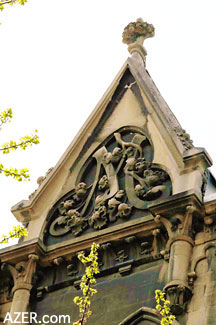  Islam Safarli Street Islam Safarli Street
One such street is Islam Safarli, previously known as Voronsovskaya
during the Czarist era, having been named after a count and governor
of 19th century Caucasus.
Left: Ornate monogram "M" atop
the elegant Malikov residence on Islam Safarli Street. This building,
like most original residences on this street, dates back to Baku's
Oil Baron period (about 1880-1920). Today many such elegant buildings
are being demolished and replaced with 15-25 story towers. Photo:
Blair.
Running north from Fountain
Square to Fuzuli Square, the street is lined with trees and mostly
two and three-story buildings of limestone that delight the eye
with architectural detail.
There are playful gargoyles supporting balconies, gratuitous
onion domes decorating roofs, and foreboding lions and graceful
gazelles carved into the stone facades.
True, Islam Safarli could use a bit of sprucing up. The stone
gargoyles propping up the balconies that extend out over the
street could be sandblasted to remove 90 years of accumulated
smoke and crud.
The (often ridiculously) elaborate ceiling moldings inside the
stairwells could use a bit of plaster and paint, and the stained-glass
windows might benefit simply from the liberal application of
soap and water. But, all in all, Islam Safarli is a pretty little
street, lined with pretty 100-year old houses that are part of
a pretty little neighborhood with a history told in stone and
glass. It's also a street that is rapidly becoming victim to
the wrecking ball and sledgehammer.
One of the handsome, old buildings on Islam Safarli Street targeted
for destruction happens to be where some of my friends live in
a second-story apartment with soaring, high ceilings, lattice
windows and a completely renovated kitchen and bath. They have
a study, three bedrooms and a living room, with windows overlooking
the Malikov Mansion across the street. Additional light comes
in from a bank of windows overlooking the central courtyard shared
by the three other traditional buildings on the block.
It's a very pleasant, airy apartment, and cost my friends a substantial
amount when they bought it three years ago. I mention the price
because I want to stress that it is not some dump or romantic
tenement. Nor are my friends without resources. He is an expatriate
employed in the oil sector; and she, a local lass, who has two
businesses of her own. And yet they are so worried about what
might happen to them if I used their real names that they have
insisted on anonymity. To say they are afraid would be an exaggeration;
but not to mention their concern would be to skirt the element
of nastiness that pervades the current building boom. So let's
just call them "Hans" and "Seva".
"The only thing we've been able to find out about our enemy
is its name - Park Company," Hans explained as we sat in
his pleasant, designer kitchen on a recent autumn Sunday. Outside,
the drone of a cement truck meant that more liquid rock was being
pumped into the frames of the monstrosity that are literally
enveloping their home. "When they started the demolition
of the building next door to clear way for their foundation,
we went to the municipality to find out what was going on."
What was happening was the piece-meal purchase, apartment by
apartment, of all the residences in the quadrant of which Hans'
and Seva's apartment made up a quarter. Once Park Company owned
an entire structure; the 100-year old buildings were pulled down.
Thus began a summer of dust, noise, despair and outrage as the
mysterious Park Company began building a 14-story high-rise monstrosity,
with each additional floor encroaching further and further into
the "air space" represented by the courtyard shared
by all. If this wasn't bad enough, the very proximity of the
construction zone outside his kitchen window enabled Hans to
study the incredibly shoddy building methods employed by the
workers of Park Company.
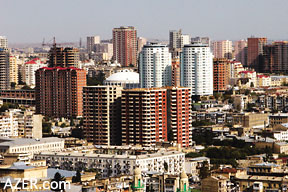  Cracks in the Concrete Cracks in the Concrete
Left: The new skline in downtown Baku: more
than 500 towers have been constructed since 2000. Photo: Pirouz
Khanlou
"I work with cement;
it's my job," spat an exasperated Hans. "And without
conducting a thorough, chemical testing of the concrete, I don't
very, very low.
But what is truly insane is that they have been pouring it in
the middle of one of the hottest summers in Azerbaijani history
- 40 degrees! [more than 100 degrees Fahrenheit]-and without
even bothering to splash on water during the drying process before
slapping up the next level. That's a guaranteed recipe for disaster."
Within weeks, cracks began to
appear in the foundation of the new building - and Hans and Seva
decided to sue Park Company through their insurance company for
flagrant building code violations. But as concrete floor after
concrete floor rose above their kitchen window, my friends were
unable to find out any information about the construction company
other than vague and veiled references to its owners being "very
well connected" and not the type of folks to fool around
with.
"Everyone is afraid," Seva told me. "They're either
afraid of the consequences of talking, or afraid of not being
able to sell their apartments to the developers if there is a
stink. I'm not sure which is worse."
Finally, Seva called in the local media to make a stand - only
to be informed that the television station was not interested
in investigating the story as long as Park Company was part of
the picture.
"The only thing we can hope for at this point is to make
a windfall profit by being the last legal residents in the quadrant,
and forcing them to buy us out at a maximum price," said
Hans. "That might sound good to some people, but the fact
of the matter is that we are being forced out of our home."
That was mid-August.
By mid-September, Seva had finally discovered who was the money
behind Park Company: suffice it to say that it is one of the
"untouchables" - an individual of wealth and influence.
Here is a recent email from Seva expressing her despair:
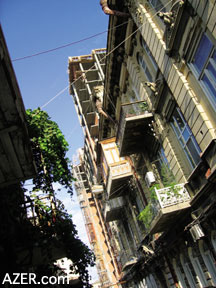  No Recourse No Recourse
"Thomas, it's getting worse and worse. Some months ago,
I made my claim at the (ABC) District Court.
Left: Many of Baku's streets in the center
of town are so narrow that only two cars can pass. And yet towers
are being built with no facilities for parking. Photo: Thomas
Goltz.
They were supposed to answer me within two weeks (according to
law), but the judge sat on it for one month and made the decision
to send it to another courts - this time in the (XYZ) district.
But the judge there is afraid of the case and doesn't want to
take it.
"Then today Park Company wrote a letter to the court refusing
to have the case heard in the (XYZ) District because the apartment
building is really in the (ABC) District.
"But you see, they're doing this deliberately to stall for
time so that they can finish construction prior to elections
[Parliament elections on November 6, 2005]. They're building
like crazy now; sometimes they complete an entire floor in a
single day. We can't sleep at nights because of the noise. Now
the Appellate Court has to decide whether the case will be handled
in the (ABC) district or the (XYZ) district. That decision could
take up to another two months.
"I want to hold a press conference with my lawyer and, if
possible, get my insurance company involved, too. If you would
be here, you could help me. You're a professional. I don't know
what to do, I'm completely lost.
"So, Thomas, this government does everything to make people
go against them. If someone is their friend, he doesn't have
to pay attention to the law or the Constitution, he can do whatever
he wants. He is king."
Hans and Seva's dilemma is not unique. Up and down Islam Safarli
and most other byways in the historical Oil Baron town, Park
Company and its ilk are buying up family homes for flash cash,
destroying the neighborhoods, and gutting the one - and two -
story buildings they acquire without reference to anything remotely
resembling a growth policy plan.
Cement trucks clog the narrow streets as they fill in shallow
foundations for new sky scrappers - morning, noon and night.
The happy workers are paid between $10 and $20 per day, depending
on their tasks, and without access to any sort of safety equipment.
All of those interviewed in the course of this investigation
declined to give their full names, lest they be fired. But all
of them agreed: none would ever have enough money to live in
the monstrous structures. Which brings up the obvious question:
for whom are these new buildings being built? One price quoted
is that a square meter now costs $3,000, which translates to
something on the order of a million dollars for a flat the size
that my friends Hans and Seva currently live in. Who, aside from
the elite few, has that sort of money or access to a mortgage?
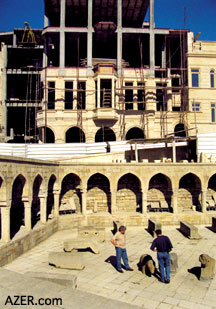  And
as for monthly rental fees, I was quoted a cool $1,300 for a
one-bedroom apartment on the fourth floor in a soulless, 20-floor
structure slapped up on Fuzuli Street. Which young professional
Azerbaijani can afford such a monthly fee? As for the foreign
market, the corporate types are already ensconced in gated communities,
and the idea that the apartments can be sold as an "investment"
can be dismissed as ridiculous. And
as for monthly rental fees, I was quoted a cool $1,300 for a
one-bedroom apartment on the fourth floor in a soulless, 20-floor
structure slapped up on Fuzuli Street. Which young professional
Azerbaijani can afford such a monthly fee? As for the foreign
market, the corporate types are already ensconced in gated communities,
and the idea that the apartments can be sold as an "investment"
can be dismissed as ridiculous.
Left: New construction going on in Baku's
Old City.
With so many "brand new" units going up, who in their
right mind would even think of buying a second-rate apartment
that is already falling apart, even if they had the money?
More likely, confidential sources
in law enforcement tell me, many of the new structures are being
built less for the lure of profit than as a means of "laundering"
black money acquired through corrupt business practices, easy
oil and possibly even narco-trafficking.
The most damning - indeed, the most criminal - aspect of the
new building boom, however, is the fact that many of the structures
thrown up, night and day, are being built of substandard concrete,
thanks to the admixture of seashore sand that contains corrosive
salts. Whole beaches along the Absheron Peninsula have now become
quarries exploited by contractors more interested in quick profits
than the long-term structural integrity of the buildings (or
the people living inside them).
And as for reinforcement rods, a best - left nameless friend
of mine informed me that the contractors only use high - stress
steel produced in Ukraine for the first six or eight stories,
and then switch to cheaper, locally produced steel for the upper
stories. I shudder to think what the next minor earthquake will
do-no pun intended.
Inadequate Infrastructure
And even if the new buildings do not fall down like a house of
cards, life within the new towers will not be very pretty. How
will the power grid handle thousands of juice-sucking air-conditioners
and elevators? Even now the city's water pumps are on their last
legs. And whether there will be sufficient water for dishwashers,
washing machines and showers is an unanswered question. And what
about the impact on the sewage system when 10,000 new toilets
all flush at once?
Meanwhile, out on the streets, heat and smog will increase exponentially.
The sheer number of new apartments will triple or quadruple the
number of residents, and will thus invite double or triple the
number of cars to squeeze into the narrow streets that were designed
for pedestrians or horse-drawn carriages. The streets are already
clogged, due to the surge in automobile ownership over the past
few years. Sidewalks are already almost a thing of the past.
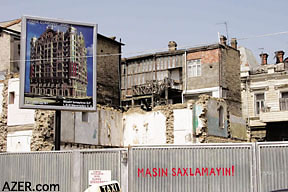  So where
does it all lead? And where and when does it all end? So where
does it all lead? And where and when does it all end?
Left: Many of Baku's old buildings of two
and three stories which date from the Oil Baron period (1880-1920)
are being replaced with poorly designed towers of strange eclectic
architecutal style. The sign on the wall reads "Do not park!"
In a recent Open Letter to First Lady Mehriban Aliyeva, in essence,
pleading for her intervention, Azerbaijani journalist Sultan
Sultanoghlu took issue by liberally (and quite appropriately)
quoting Karl Marx: "'Capital is happy with a 20-percent
return, delighted with a 50-percent return, ecstatic with a 100-percent
return, delirious with a 200-percent return. And with a 300-percent
return, Capital becomes insane. And the return rate in the building
boom in Baku is 300 percent.' Something must be done before it
is too late."
According to a good friend of mine who has friends investing
in the construction craze, the numbers quoted above are not even
true. "In two years, my friends hope to make a $50 million
profit on a $3 million investment," my source wrote. "It's
a chance of a lifetime!"
But at what cost!
Stop!
Thomas Goltz, who lives in Montana, is the author of "Azerbaijan
Diary" (M.E. Sharpe 1998/99) and "Chechnya Diary: A
War Correspondent's Story of Surviving the War in Chechnya"
(St Martin's Press, 2003). A new book about Georgia is scheduled
for 2006 (M.E. Sharpe). This will be Goltz' third book related
to Post-Soviet ethnic conflicts in the Caucasus.
From Azerbaijan International (13.3) Autumn 2005.
© Azerbaijan International 2005. All rights reserved.
Back to Index AI
13.3 (Autumn 2005)
AI Home
| Search | Magazine
Choice
| Topics
| AI Store | Contact us
Other Web sites
created by Azerbaijan International
AZgallery.org | AZERI.org | HAJIBEYOV.com
|






